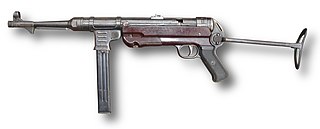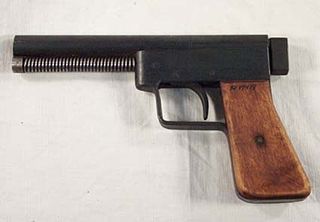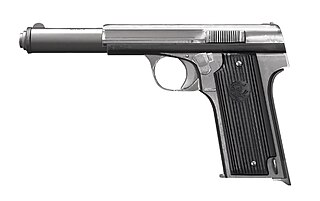
A submachine gun (SMG) is a magazine-fed automatic carbine designed to fire handgun cartridges. The term "submachine gun" was coined by John T. Thompson, the inventor of the Thompson submachine gun, to describe its design concept as an automatic firearm with notably less firepower than a machine gun. As a machine gun must fire rifle cartridges to be classified as such, submachine guns are not considered machine guns.

The Thompson submachine gun is a blowback-operated, selective-fire submachine gun, invented and developed by United States Army Brigadier General John T. Thompson in 1918. It was designed to break the stalemate of trench warfare of World War I, although early models did not arrive in time for actual combat.

The Colt M1911 is a single-action, recoil-operated, semi-automatic pistol chambered for the .45 ACP cartridge. The pistol's formal U.S. military designation as of 1940 was Automatic Pistol, Caliber .45, M1911 for the original model adopted in March 1911, and Automatic Pistol, Caliber .45, M1911A1 for the improved M1911A1 model which entered service in 1926. The designation changed to Pistol, Caliber .45, Automatic, M1911A1 in the Vietnam War era.

The MP 40 is a submachine gun chambered for the 9×19mm Parabellum cartridge. It was developed in Nazi Germany and used extensively by the Axis powers during World War II.

The STEN is a British submachine gun chambered in 9×19mm which was used extensively by British and Commonwealth forces throughout World War II and post war including the Korean War. The Sten was a simple design with very low production cost for mass production to meet demand for submachine guns.

The .45 Reising submachine gun was manufactured by Harrington & Richardson (H&R) Arms Company in Worcester, Massachusetts, USA, and was designed and patented by Eugene Reising in 1940. The three versions of the weapon were the Model 50, the folding stock Model 55, and the semiautomatic Model 60 rifle. Over 100,000 Reisings were ordered during World War II, and were initially used by the United States Navy, Marine Corps, and the United States Coast Guard, though some were shipped to Canadian, Soviet, and other allied forces to fight the Axis powers.

The Military Armament Corporation Model 10, officially abbreviated as "M10" or "M-10", and more commonly known as the MAC-10, is a compact, blowback operated machine pistol/submachine gun that was developed by Gordon B. Ingram in 1964. It is chambered in either .45 ACP or 9mm. A two-stage suppressor by Sionics was designed for the MAC-10, which not only abates the noise created but makes it easier to control on full automatic.

The .45 ACP, also known as .45 Auto, .45 Automatic, or 11.43×23mm is a rimless straight-walled handgun cartridge designed by John Moses Browning in 1904, for use in his prototype Colt semi-automatic pistol. After successful military trials, it was adopted as the standard chambering for Colt's M1911 pistol. The round was developed due to a lack of stopping power experienced in the Moro Rebellion in places like Sulu. The issued ammunition, .38 Long Colt, had proved inadequate, motivating the search for a better cartridge. This experience and the Thompson–LaGarde Tests of 1904 led the Army and the Cavalry to decide that a minimum of .45 caliber was required in a new handgun cartridge.

The .380 ACP, is a rimless, straight-walled pistol cartridge developed by firearms designer John Moses Browning. The cartridge headspaces on the mouth of the case. It was introduced in 1908 by Colt, for use in its new Colt Model 1908 pocket hammerless semi-automatic, and has been a popular self-defense cartridge ever since, seeing wide use in numerous handguns. Other names for .380 ACP include .380 Auto, 9×17mm, 9mm Browning, 9mm Corto, 9mm Kurz, 9mm Short, and 9mm Browning Court. It should not be confused with .38 ACP. The .380 ACP does not strictly conform to cartridge naming conventions, named after the diameter of the bullet, as the actual bullet diameter of the .380 ACP is .355 inches.
The Suomi KP/-31 is a Finnish submachine gun that was mainly used during World War II. It is a descendant of the M-22 prototype and the KP/-26 production model, which was revealed to the public in 1925. It entered service in Finland in 1931, and remained in use until the 1980s.

The Hyde-Inland M2 was a United States submachine gun design submitted for trials at Aberdeen Proving Ground in February 1941. Work was undertaken by General Motors Inland Manufacturing Division to develop workable prototypes of George Hyde's design patented in 1935. The model first submitted for trials in April 1942 was designated the Hyde-Inland 1. Trials revealed the design was superior to the M1 submachine gun in mud and dirt tests, and its accuracy in full-automatic firing was better than any other submachine gun tested at the time. An improved Hyde-Inland 2 was designated U.S. Submachine gun, Caliber .45, M2 as a substitute standard for the M1 Thompson in April 1942. As Inland's manufacturing capacity became focused on M1 carbine production, the US Army contracted M2 production to Marlin Firearms in July 1942. Marlin began production in May 1943. Marlin's production failed to match the trials prototype performance; and Marlin's original contract for 164,450 M2s was canceled in 1943 upon adoption of the M3 submachine gun. The M2 is chambered for the .45 ACP cartridge and used the same 20- or 30-round magazine as the Thompson. Its cyclic rate of fire is 570 rounds per minute. None of the approximately 400 manufactured were issued by any branches of the United States military.
The MP34 is a submachine gun (SMG) that was manufactured by Waffenfabrik Steyr as Steyr-Solothurn S1-100 and used by the Austrian Army and Austrian Gendarmerie and subsequently by units of the German Army and the Waffen SS, in World War II. An exceptionally well-made weapon, it was used by some forces well into the 1970s.

The PPSh-41 is a selective-fire, open-bolt, blowback submachine gun that fires the 7.62×25mm Tokarev round. It was designed by Georgy Shpagin of the Soviet Union to be a cheaper and simplified alternative to the PPD-40.

Star Bonifacio Echeverria, S.A. was a manufacturer of small arms in the Basque region of Spain from about 1905 until 1997.

The Frommer Stop is a Hungarian long-recoil, rotating bolt pistol manufactured by Fémáru, Fegyver és Gépgyár (FÉG) in Budapest. It was designed by Rudolf Frommer, and its original design was adopted as the Pisztoly 12M in 1912, created for the Royal Hungarian Army. The handgun was manufactured in various forms from 1912 to 1945 and used in the Hungarian Armed Forces as well as, during the First World War, by the Ottoman Army in limited quantities. The Stop is 165 millimeters (6.5 in) long with a 95 millimeters (3.7 in) 4-groove rifled barrel. Unloaded weight is 610 g (22 oz), and the detachable box magazine holds seven rounds.

Improvised firearms are firearms manufactured other than by a firearms manufacturer or a gunsmith, and are typically constructed by adapting existing materials to the purpose. They range in quality from crude weapons that are as much a danger to the user as the target to high-quality arms produced by cottage industries using salvaged and repurposed materials.

The M3 is an American .45-caliber submachine gun adopted by the U.S. Army on 12 December 1942, as the United States Submachine Gun, Cal. .45, M3. The M3 was chambered for the same .45 ACP round fired by the Thompson submachine gun, but was cheaper to mass produce and lighter, at the expense of accuracy. The M3 was commonly referred to as the "Grease Gun" or simply "the Greaser," owing to its visual similarity to the mechanic's tool.

The Astra modelo 400 was a Spanish service pistol produced by weapons manufacturer Astra-Unceta y Cia SA. as a replacement for the Campo-Giro 1913/1916, which had also been chambered in 9mm Largo. It was the standard issue sidearm in the Spanish Army during the Spanish Civil War and also saw service in Germany during World War II.

Auto-Ordnance was a U.S. arms development firm founded by retired Colonel John T. Thompson of the United States Army Ordnance Department in 1916. Auto-Ordnance is best known for the Thompson submachine gun, used as a military weapon by the Allied forces in World War II, and also notorious as a gangster weapon used during the Roaring Twenties.

















